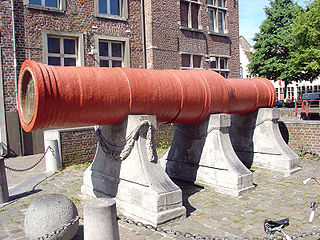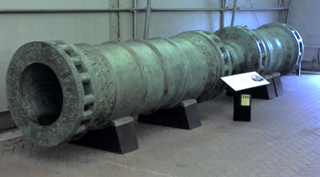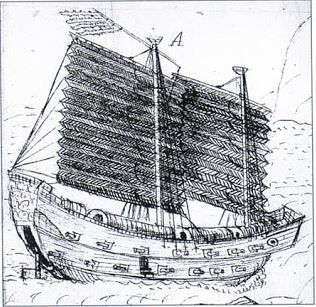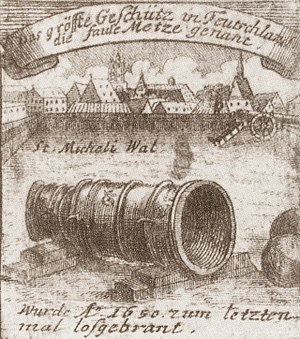A cannon is a large-caliber gun classified as a type of artillery, which usually launches a projectile using explosive chemical propellant. Gunpowder was the primary propellant before the invention of smokeless powder during the late 19th century. Cannons vary in gauge, effective range, mobility, rate of fire, angle of fire and firepower; different forms of cannon combine and balance these attributes in varying degrees, depending on their intended use on the battlefield. A cannon is a type of heavy artillery weapon.

The formal definition of large-calibre artillery used by the United Nations Register of Conventional Arms (UNROCA) is "guns, howitzers, artillery pieces, combining the characteristics of a gun, howitzer, mortar, or multiple-launch rocket system, capable of engaging surface targets by delivering primarily indirect fire, with a calibre of 75 millimetres and above". This definition, shared by the Arms Trade Treaty and the Treaty on Conventional Armed Forces in Europe, is derived from a definition in United Nations General Assembly Resolution 46/36L, which set a threshold of 100mm. Several grammatical changes were made to that latter in 1992 and the threshold was lowered in 2003 to yield the current definition, as endorsed by UN General Assembly Resolution 58/54.

Schwerer Gustav was a German 80-centimetre (31.5 in) railway gun. It was developed in the late 1930s by Krupp in Rügenwalde as siege artillery for the explicit purpose of destroying the main forts of the French Maginot Line, the strongest fortifications in existence at the time. The fully assembled gun weighed nearly 1,350 tonnes, and could fire shells weighing 7 t to a range of 47 km (29 mi).

A ranged weapon is any weapon that can engage targets beyond hand-to-hand distance, i.e. at distances greater than the physical reach of the user holding the weapon itself. The act of using such a weapon is also known as shooting. It is sometimes also called projectile weapon or missile weapon because it typically works by launching solid projectiles ("missiles"), though technically a fluid-projector and a directed-energy weapon are also ranged weapons. In contrast, a weapon intended to be used in hand-to-hand combat is called a melee weapon.

Mons Meg is a medieval bombard in the collection of the Royal Armouries, on loan to Historic Scotland and located at Edinburgh Castle in Scotland. It has a barrel diameter of 20 inches (510 mm) making it one of the largest cannons in the world by calibre.

The bombard is a type of cannon or mortar which was used throughout the Middle Ages and the early modern period. Bombards were mainly large calibre, muzzle-loading artillery pieces used during sieges to shoot round stone projectiles at the walls of enemy fortifications, enabling troops to break in. Most bombards were made of iron and used gunpowder to launch the projectiles. There are many examples of bombards, including Mons Meg, the Dardanelles Gun, and the handheld bombard.

The Basillica or Great Turkish Bombard is a 15th-century siege cannon, specifically a super-sized bombard, which saw action in the 1807 Dardanelles operation. It was built in 1464 by Ottoman military engineer Munir Ali and modelled after the Orban bombard that was used for the Ottoman besiegers of Constantinople in 1453.

The Dulle Griet is a medieval large-calibre gun founded in Gent (Ghent).
The history of cannons spans several hundred years from the 12th century to modern times. The cannon first appeared in China sometime during the 12th and 13th centuries. It was most likely developed in parallel or as an evolution of an earlier gunpowder weapon called the fire lance. The result was a projectile weapon in the shape of a cylinder that fired projectiles using the explosive pressure of gunpowder. Cannons were used for warfare by the late 13th century in the Yuan dynasty and spread throughout Eurasia in the 14th century. During the Middle Ages, large and small cannons were developed for siege and field battles. The cannon replaced prior siege weapons such as the trebuchet. After the Middle Ages, most large cannons were abandoned in favor of greater numbers of lighter, more maneuverable field artillery. New defensive fortifications such as bastions and star forts were designed specifically to better withstand artillery sieges. Cannons transformed naval warfare with its deadly firepower, allowing vessels to destroy each other from long range. As rifling became more commonplace, the accuracy of the cannon was significantly improved, and they became deadlier than ever, especially to infantry. In World War I, a considerable majority of all deaths were caused by cannons; they were also used widely in World War II. Most modern cannons are similar to those used in the Second World War, including autocannons—with the exception of naval guns, which are now significantly smaller in caliber.

Orban, also known as Urban, was an iron founder and engineer from Brassó, Transylvania, in the Kingdom of Hungary, who cast large-calibre artillery for the Ottoman siege of Constantinople in 1453.

Military forces of the Ottoman Empire used a variety of weapons throughout the centuries. The armoury in Topkapı Palace has a large collection of which it shows select items.

The 7.5 cm GebG 36(German: 7.5 cm Gebirgsgeschütz 36) was a 7.5 cm (3.0 in) German mountain gun used during World War II. At least 1,193 were built between 1938 and 1945. It was the standard light gun of the German mountain divisions, both Army and Waffen-SS, during World War II.

The Faule Grete was a medieval large-calibre cannon of the Teutonic Order. The bronze bombard was cast in 1409 in the cannon foundry of the Marienburg by the gunfounder Heynrich Dumechen. According to the account books of the order, the construction costs amounted to 278.5 Mark, a sum equivalent to ca. 1160 oxen.

The Pumhart von Steyr is a medieval large-calibre cannon from Styria, Austria, and the largest known wrought-iron bombard by caliber. It weighs around 8 tons and has a length of more than 2.5 meters. It was produced in the early 15th century and could fire, according to modern calculations, an 80 cm stone ball weighing 690 kg to a distance of roughly 600 m after being loaded with 15 kg of gunpowder and set at an elevation of 10°.
The Grose Bochse was a medieval large-calibre cannon of the Teutonic Order. It was cast from June to September 1408 in several pieces and was presumably assembled by a screw or plug connection. The cannon was even bigger than the slightly later finished Faule Grete and may have reached the dimensions of the largest known bombard by caliber, the Pumhart von Steyr.

A breech-loading swivel gun was a particular type of swivel gun and a small breech-loading cannon invented in the 14th century. It was equipped with a swivel for easy rotation and was loaded by inserting a mug-shaped device called a chamber or breech block, filled with gunpowder and projectiles. It had a high rate of fire, as several chambers could be prepared in advance and quickly fired in succession and was especially effective in anti-personnel roles. It was used for centuries by many countries of Europe, Asia and Africa.

The 68-pounder cannon was an artillery piece designed and used by the British Armed Forces in the mid-19th century. The cannon was a smoothbore muzzle-loading gun manufactured in several weights, the most common being 95 long cwt (4,800 kg), and fired projectiles of 68 lb (31 kg). Colonel William Dundas designed the 112 cwt version in 1841 and it was cast the following year. The most common variant, weighing 95 cwt, dates from 1846. It entered service with the Royal Artillery and the Royal Navy and saw active service with both arms during the Crimean War. Over 2,000 were made and it gained a reputation as the finest smoothbore cannon ever made.

The Ming dynasty continued to improve on gunpowder weapons from the Yuan and Song dynasties. During the early Ming period larger and more cannons were used in warfare. In the early 16th century Turkish and Portuguese breech-loading swivel guns and matchlock firearms were incorporated into the Ming arsenal. In the 17th century Dutch culverin were incorporated as well and became known as hongyipao. At the very end of the Ming dynasty, around 1642, Chinese combined European cannon designs with indigenous casting methods to create composite metal cannons that exemplified the best attributes of both iron and bronze cannons. While firearms never completely displaced the bow and arrow, by the end of the 16th century more firearms than bows were being ordered for production by the government, and no crossbows were mentioned at all.














